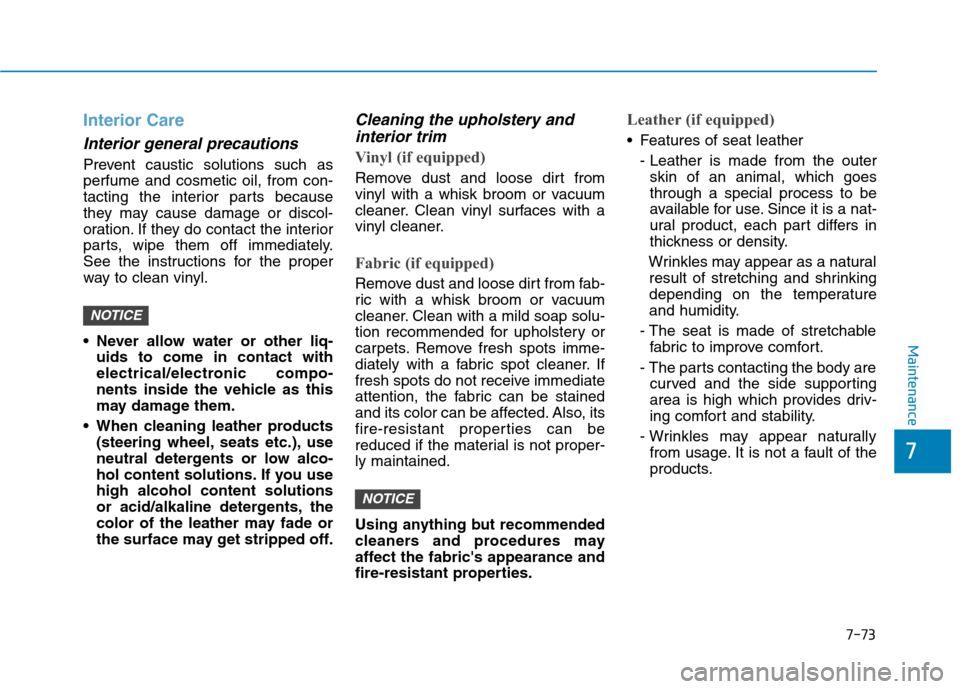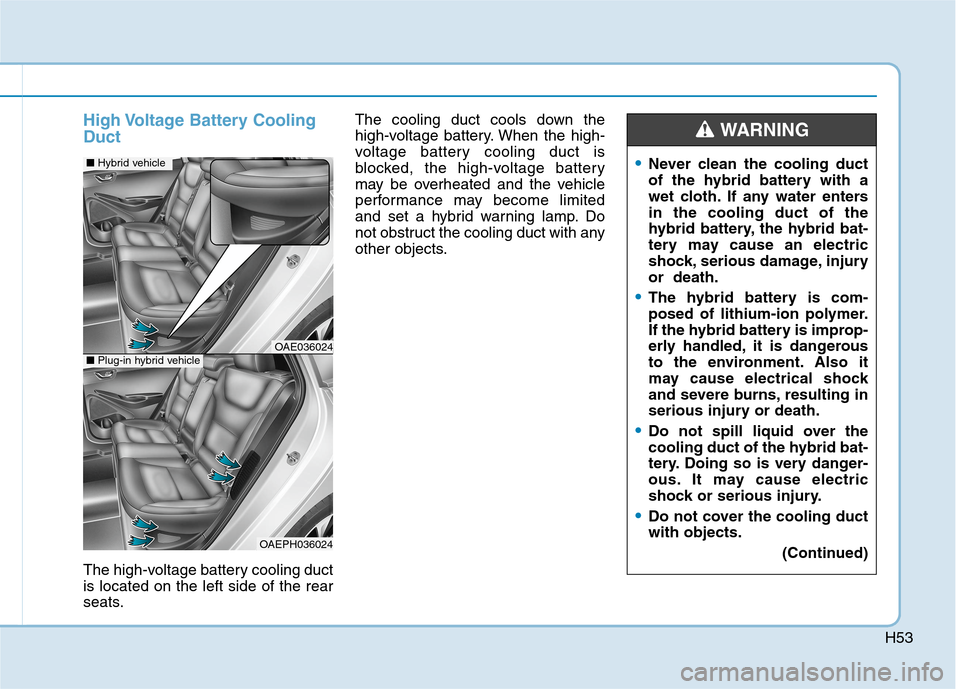2020 Hyundai Ioniq Plug-in Hybrid seats
[x] Cancel search: seatsPage 436 of 635

5-170
Driving your vehicle
Overloading your vehicle may
cause damage. Repairs would not
be covered by your warranty. Do
not overload your vehicle.We do not recommend using this
vehicle for trailer towing.
NOTICE
T TR
RA
AI
IL
LE
ER
R
T
TO
OW
WI
IN
NG
G
If you carry items inside your
vehicle (e.g., suitcases, tools,
packages, or anything else),
they are moving as fast as the
vehicle. If you have to stop or
turn quickly, or if there is a
crash, the items will keep going
and can cause an injury if they
strike the driver or a passenger.
Put items in the cargo area of
your vehicle. Try to spread the
weight evenly.
Do not stack items, like suit-
cases, inside the vehicle
above the tops of the seats.
Do not leave an unsecured
child restraint in your vehicle.
When you carry something
inside the vehicle, secure it.
WARNING
Page 524 of 635

7-44
Maintenance
Tire Terminology and
Definitions
Air Pressure
The amount of air inside the tire
pressing outward on the tire. Air
pressure is expressed in pounds per
square inch (psi) or kilopascal (kPa).
Accessory Weight
This means the combined weight of
optional accessories. Some exam-
ples of optional accessories are
automatic transmission, power
seats, and air conditioning.
Aspect Ratio
The relationship of a tire's height to
its width.
Belt
A rubber coated layer of cords that is
located between the plies and the
tread. Cords may be made from steel
or other reinforcing materials.
Bead
The tire bead contains steel wires
wrapped by steel cords that hold the
tire onto the rim.
Bias Ply Tire
A pneumatic tire in which the plies
are laid at alternate angles less than
90 degrees to the centerline of the
tread.
Cold Tire Pressure
The amount of air pressure in a tire,
measured in pounds per square inch
(psi) or kilopascals (kPa) before a tire
has built up heat from driving.
Curb Weight
This means the weight of a motor
vehicle with standard and optional
equipment including the maximum
capacity of fuel, oil and coolant, but
without passengers and cargo.
DOT Markings
A code molded into the sidewall of a
tire signifying that the tire is in com-
pliance with the U.S. Department of
Transportation motor vehicle safety
standards. The DOT code includes
the Tire Identification Number (TIN),
an alphanumeric designator which
can also identify the tire manufactur-
er, production plant, brand and date
of production.
GVWR
Gross Vehicle Weight Rating
GAWR FRT
Gross Axle Weight Rating for the
Front Axle.
GAWR RR
Gross Axle Weight Rating for the
Rear axle.
Intended Outboard Sidewall
The side of an asymmetrical tire, that
must always face outward when
mounted on a vehicle.
Page 553 of 635

7-73
7
Maintenance
Interior Care
Interior general precautions
Prevent caustic solutions such as
perfume and cosmetic oil, from con-
tacting the interior parts because
they may cause damage or discol-
oration. If they do contact the interior
parts, wipe them off immediately.
See the instructions for the proper
way to clean vinyl.
Never allow water or other liq-
uids to come in contact with
electrical/electronic compo-
nents inside the vehicle as this
may damage them.
When cleaning leather products
(steering wheel, seats etc.), use
neutral detergents or low alco-
hol content solutions. If you use
high alcohol content solutions
or acid/alkaline detergents, the
color of the leather may fade or
the surface may get stripped off.
Cleaning the upholstery and
interior trim
Vinyl (if equipped)
Remove dust and loose dirt from
vinyl with a whisk broom or vacuum
cleaner. Clean vinyl surfaces with a
vinyl cleaner.
Fabric (if equipped)
Remove dust and loose dirt from fab-
ric with a whisk broom or vacuum
cleaner. Clean with a mild soap solu-
tion recommended for upholstery or
carpets. Remove fresh spots imme-
diately with a fabric spot cleaner. If
fresh spots do not receive immediate
attention, the fabric can be stained
and its color can be affected. Also, its
fire-resistant properties can be
reduced if the material is not proper-
ly maintained.
Using anything but recommended
cleaners and procedures may
affect the fabric's appearance and
fire-resistant properties.
Leather (if equipped)
Features of seat leather
- Leather is made from the outer
skin of an animal, which goes
through a special process to be
available for use. Since it is a nat-
ural product, each part differs in
thickness or density.
Wrinkles may appear as a natural
result of stretching and shrinking
depending on the temperature
and humidity.
- The seat is made of stretchable
fabric to improve comfort.
- The parts contacting the body are
curved and the side supporting
area is high which provides driv-
ing comfort and stability.
- Wrinkles may appear naturally
from usage. It is not a fault of the
products.
NOTICE
NOTICE
Page 554 of 635

Wrinkles or abrasions which
appear naturally from usage are
not covered by warranty.
Belts with metallic accessories,
zippers or keys inside the back
pocket may damage the seat
fabric.
Make sure not to wet the seat. It
may change the nature of natu-
ral leather.
Jeans or clothes which could
bleach may contaminate the sur-
face of the seat covering fabric. Caring for the leather seats
- Vacuum the seat periodically to
remove dust and sand on the seat.
It will prevent abrasion or damage
of the leather and maintain its qual-
ity.
- Wipe the natural leather seat cover
often with dry or soft cloth.
- Use of proper leather protector
may prevent abrasion of the cover
and helps maintain the color. Be
sure to read the instructions and
consult a specialist when using
leather coating or protective agent.
- Light colored (beige, cream beige)
leather is easily contaminated and
the stain is noticeable. Clean the
seats frequently.
- Avoid wiping with wet cloth. It may
cause the surface to crack. Cleaning the leather seats
- Remove all contaminations instant-
ly. Refer to instructions below for
removal of each contaminant.
- Cosmetic products (sunscreen,
foundation, etc.)
Apply cleansing cream on a cloth
and wipe the contaminated spot.
Wipe off the cream with a wet cloth
and remove water with a dry cloth.
- Beverages (coffee, soft drink, etc.)
Apply a small amount of neutral
detergent and wipe until contami-
nations do not smear.
- Oil
Remove oil instantly with
absorbable cloth and wipe with
stain remover used only for natu-
ral leather.
- Chewing gum
Harden the gum with ice and
remove gradually.
NOTICE
7-74
Maintenance
Page 620 of 635

H49
High Voltage Battery System
*1: Located in the engine compartment
*
2: Located under the rear seats
OAEPH088005
OAEQ046019
■ HPCU (Hybrid Power Control Unit)*1
■ High Voltage Battery System*2
Never touch orange colored or
high voltage labeled compo-
nents, including wires, cables,
and connections. When the insu-
lators or covers are damaged or
removed, severe injury or death
from electrocution may occur.
WARNING
While replacing the fuses in the
engine compartment, never
touch the HPCU. The HPCU car-
ries high voltage. Touching the
HPCU may result in electrocu-
tion, serious injury, or death.
WARNING
In the hybrid system, the hybrid
battery uses high voltage to
operate the motor and other
components. This high voltage
hybrid battery system can be
very dangerous. Never touch the
hybrid system. When you touch
the hybrid battery system, seri-
ous injury or death may occur.
WARNING
S SA
AF
FE
ET
TY
Y
P
PR
RE
EC
CA
AU
UT
TI
IO
ON
NS
S
F
FO
OR
R
H
HY
YB
BR
RI
ID
D
S
SY
YS
ST
TE
EM
M
Page 624 of 635

H53
High Voltage Battery Cooling
Duct
The high-voltage battery cooling duct
is located on the left side of the rear
seats.The cooling duct cools down the
high-voltage battery. When the high-
voltage battery cooling duct is
blocked, the high-voltage battery
may be overheated and the vehicle
performance may become limited
and set a hybrid warning lamp. Do
not obstruct the cooling duct with any
other objects.
OAE036024
■Hybrid vehicle
OAEPH036024
■Plug-in hybrid vehicle
Never clean the cooling duct
of the hybrid battery with a
wet cloth. If any water enters
in the cooling duct of the
hybrid battery, the hybrid bat-
tery may cause an electric
shock, serious damage, injury
or death.
The hybrid battery is com-
posed of lithium-ion polymer.
If the hybrid battery is improp-
erly handled, it is dangerous
to the environment. Also it
may cause electrical shock
and severe burns, resulting in
serious injury or death.
Do not spill liquid over the
cooling duct of the hybrid bat-
tery. Doing so is very danger-
ous. It may cause electric
shock or serious injury.
Do not cover the cooling duct
with objects.
(Continued)
WARNING
Page 633 of 635

I-7
Scheduled maintenance services.......................................7-8
Maintenance Under Severe Usage Conditions...........7-12
Normal Maintenance Schedule ....................................7-9
Severe driving conditions ...........................................7-13
Seat belts .........................................................................2-23
Additional Seat Belt Safety Precautions ....................2-32
Care of Seat Belts .......................................................2-35
Seat Belt Restraint System .........................................2-25
Seat Belt Safety Precautions ......................................2-23
Seat Belt Warning Light .............................................2-24
Seats ..................................................................................2-4
Battery Cooling Duct .................................................2-22
Front Seats ....................................................................2-6
Head Restraints ..........................................................2-16
Rear Seats ...................................................................2-12
Safety Precautions ........................................................2-5
Seat warmers ..............................................................2-20
Smart cruise control .....................................................5-112
Limitations of the system .........................................5-125
Sensor to detect distance to the vehicle ahead .........5-123
Smart Cruise Control speed......................................5-115
Smart Cruise Control Vehicle-to-Vehicle Distance ..5-120
To adjust the sensitivity of Smart cruise control......5-114
To convert to Cruise Control mode ..........................5-114Special driving conditions ............................................5-158
Driving at Night .......................................................5-159
Driving in Flooded Areas .........................................5-160
Driving in the Rain ...................................................5-159
Hazardous Driving Conditions .................................5-158
Highway Driving ......................................................5-160
Rocking the Vehicle ..............................................5-158
Smooth Cornering ....................................................5-159
Steering wheel.................................................................3-16
Electric Power Steering (EPS) ...................................3-16
Heated Steering Wheel (for Canada) .........................3-18
Horn ............................................................................3-17
Tilt Steering / Telescope Steering ..............................3-16
Storage compartment ....................................................3-160
Center Console Storage ............................................3-160
Glove Box ................................................................3-160
Multi Box .................................................................3-161
Sunglass Holder........................................................3-161
Sunroof............................................................................3-45
Resetting the Sunroof .................................................3-48
Sliding the Sunroof ....................................................3-46
Sunroof Opening and Closing ....................................3-46
Sunshade.....................................................................3-47
Tilting the Sunroof .....................................................3-47
I
Index
S